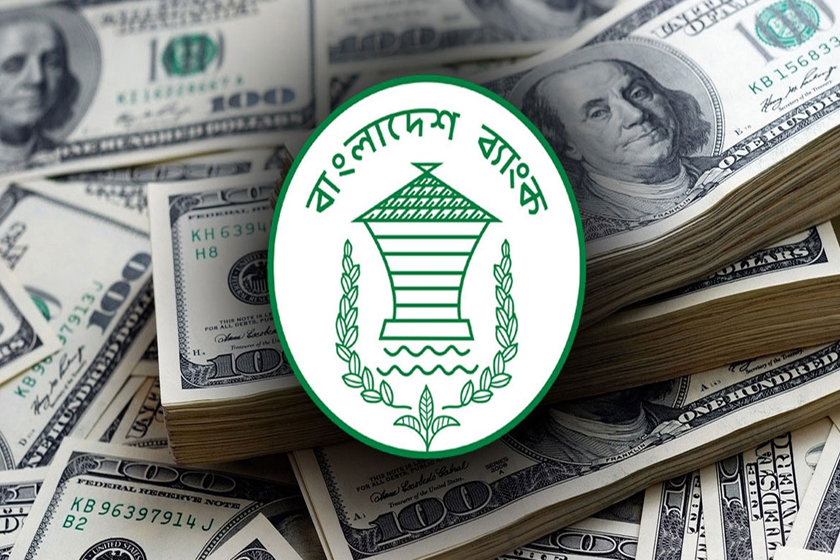
Every year before Eid, remittance or expatriate income increases compared to normal time. This time was no exception. Expatriate Bangladeshis sent foreign currency equivalent to Tk 19,432 crore in 14 days during Eid. Besides, export income has also come. As a result, foreign exchange savings or reserves have also increased. However, gross reserves have yet to cross the $25 billion mark.
Bangladesh Bank's reserves peaked at $48 billion (48 billion) in August 2021. According to the latest data from the central bank, the gross reserve as of June 19 is 2,478 crore or 24.78 billion dollars. But according to the conditions of International Monetary Fund (IMF) BPM-6 manual gross reserve is 1 thousand 952 crores or 19.52 billion dollars. As of June 12, gross reserves were 24.52 billion dollars, according to BPM-6 manual was 19.21 billion. In one week, gross reserves increased by 26 million dollars and according to BPM-6 increased by 318.2 million dollars.
At the beginning of this month, on June 5, gross reserves were 24.23 billion dollars and according to BPM-6 were 18.62 billion dollars.
But apart from this, there is another account of net or real reserves of Bangladesh Bank, which is given by the central bank only to the IMF. Not published elsewhere. There, usable reserves are calculated excluding dollars held in the IMF's SDR sector, foreign exchange clearing funds held by banks and Akur bills.
According to related sources, the country's actual expendable reserves are now 14 billion dollars. There is no ability to meet three months of import expenses with this reserve of 5 billion dollars per month. Normally a country should have reserves equal to minimum 3 months import cost. By that standard, Bangladesh is now in the worst index. One of the indicators of a country's economy is its foreign exchange reserves.
How is the reserve created?
Foreign exchange reserves are made up of dollars received from remittances, export earnings, foreign investment, loans from various countries and international organizations. Again, the foreign currency goes through the expenditure incurred in various sectors including import expenditure, loan interest or installment payment, salary and allowance of foreign workers, tourist or student education. Thus, the dollar remaining after income and expenditure is added to the reserve. And if the cost is more, the reserve decreases.
Due to high prices of fuel and various products in the international market, the cost of imports has not decreased but has increased. Besides, global trade could not turn around after Corona. Then the Russia-Ukraine war began. As a result, the dollar-crisis in the country became evident; which is still ongoing. This crisis is increasing day by day. The central bank is regularly selling dollars from reserves to bring 'stability' to the market. As a result, this index, one of the most important and sensitive of the economy, is continuously downward.
On January 30, 2023, the IMF approved a USD 4.7 billion loan program for Bangladesh. At this time several conditions were given including some policy reforms. After the start of the loan program, Bangladesh received more than 1 billion dollars in two installments. The third installment of $700 million is due by the end of June.
One of the conditions of the loan given by the IMF to Bangladesh is to maintain real reserves as per their target. According to that, the real reserve in Bangladesh Bank at the end of last March should be 1 thousand 926 billion US dollars. But at that time the actual reserve was less than 1 thousand 5 billion dollars. Besides, by June, the target was 2 thousand 10 million dollars. However, due to repeated failure to meet the target, the IMF has slightly relaxed the conditions for preserving reserves in view of Bangladesh's request.
The latest agency said the June-based reserve target was cut to $14.76 billion from $20.10 billion. That is, the actual reserve should be kept at 14.76 billion by June.
According to the data of the central bank report, the reserve was 21.50 billion dollars in the financial year 2013-14. In the fiscal year 2014-15 it was 25.02 billion dollars. 30.35 billion dollars in 2015-16. 33.67 billion dollars in 2016-17 fiscal year. Reserves in 2017-18 were $32.94 billion. In the fiscal year 2018-19 it was 32.71 billion dollars. 36.3 billion in the financial year 2019-20. Reserves for the fiscal year 2020-21 were $46.39 billion. In the fiscal year 2021-22, the reserve decreased to 41.82 billion dollars and lastly in the fiscal year 2022-23, it stood at 31 billion dollars.
Selling dollars from reserves
The central bank is continuously selling dollars from the country's foreign currency savings or reserves to reduce the dollar crisis in the market. In the current financial year, Bangladesh Bank has sold 14 billion dollars to various banks in 11 months (July-May) to meet import liabilities. During this time, it collected 4.93 billion dollars from commercial banks through currency swap system. Net sales are calculated from reserves by excluding purchased dollars. As a result, in 11 months, the amount of net sales from reserves stood at 9.8 billion or 9.80 billion dollars.
Earlier in the last financial year 2022-23, the central bank sold 13.58 billion dollars to various banks. And in the previous fiscal year (2021-22), dollars sold 7.62 billion dollars.












0 Comments